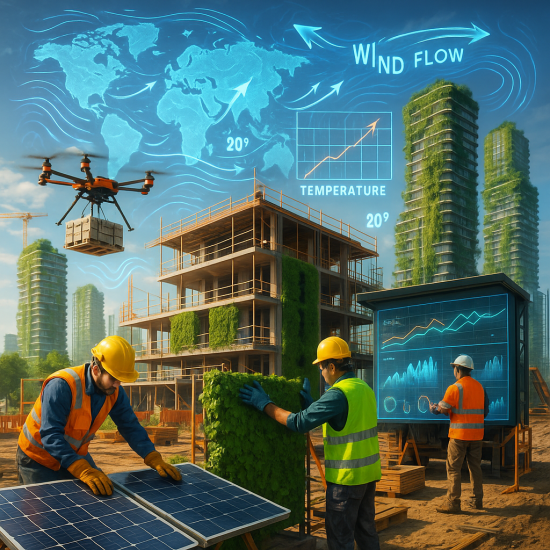How AI-Powered Climate Modeling Is Reshaping Sustainable Construction in 2025

In 2025, the construction industry is undergoing a seismic shift—driven not by concrete or steel, but by algorithms and data. As climate change accelerates and environmental regulations tighten, AI-powered climate modeling is emerging as a game-changing tool for sustainable construction. This technology is helping builders, architects, and developers make smarter decisions that reduce environmental impact, cut costs, and future-proof their projects.
Why Climate Modeling Matters More Than Ever
The construction sector is responsible for nearly 40% of global carbon emissions. With governments worldwide enforcing stricter building codes and sustainability benchmarks, the pressure is on to build greener. Traditional climate modeling methods—often slow, expensive, and limited in scope—are no longer sufficient.
Enter AI.
AI-driven climate models can process vast datasets in real time, simulate future climate scenarios, and provide hyper-local insights. This allows construction professionals to anticipate risks like flooding, heatwaves, or wind stress before breaking ground.
Real-World Applications in 2025
Here’s how AI climate modeling is already transforming the construction landscape:
- Site Selection and Risk Assessment: AI tools analyze topography, weather patterns, and environmental data to identify optimal building sites and flag potential hazards.
- Material Optimization: Predictive models recommend materials that perform best under projected climate conditions, improving durability and reducing maintenance.
- Energy Efficiency Planning: AI simulations help design buildings that maximize natural light, ventilation, and insulation—cutting energy use and emissions.
- Regulatory Compliance: Automated modeling ensures designs meet evolving green building standards like LEED, BREEAM, and local mandates.
Case Study: SmartBuild Group’s Net-Zero Campus
In early 2025, SmartBuild Group used AI climate modeling to design a net-zero university campus in Arizona. The system simulated 50 years of climate data to optimize building orientation, select heat-resistant materials, and integrate solar shading. The result? A 38% reduction in projected cooling costs and a LEED Platinum certification—achieved six months ahead of schedule.
Benefits Beyond Sustainability
While the environmental impact is significant, AI climate modeling also delivers business value:
- Cost Savings: Early risk detection and optimized resource use reduce project delays and budget overruns.
- Investor Confidence: Sustainable, climate-resilient projects are more attractive to ESG-focused investors.
- Brand Reputation: Companies that embrace green tech gain a competitive edge in a market increasingly driven by eco-conscious consumers.
Challenges and Considerations
Despite its promise, AI climate modeling isn’t without hurdles:
- Data Quality: Inaccurate or incomplete data can skew predictions.
- Skill Gaps: Many firms lack in-house expertise to interpret AI outputs effectively.
- Integration: Aligning AI tools with existing BIM and project management systems requires upfront investment.
However, as platforms become more user-friendly and training more accessible, these barriers are rapidly diminishing.
What Construction Professionals Should Do Now
To stay ahead of the curve, consider these steps:
- Audit Your Current Tech Stack: Identify gaps where AI modeling could add value.
- Partner with Experts: Collaborate with climate scientists or AI consultants to interpret data effectively.
- Start Small: Pilot AI tools on a single project before scaling up.
- Stay Informed: Follow updates from organizations like the World Green Building Council and Construction Dive.
The Future Is Predictive
As climate volatility becomes the new normal, reactive planning is no longer enough. AI-powered climate modeling offers a proactive, data-driven path to sustainable construction—one that balances environmental responsibility with economic viability.
In 2025 and beyond, the smartest buildings won’t just be connected—they’ll be climate-aware.